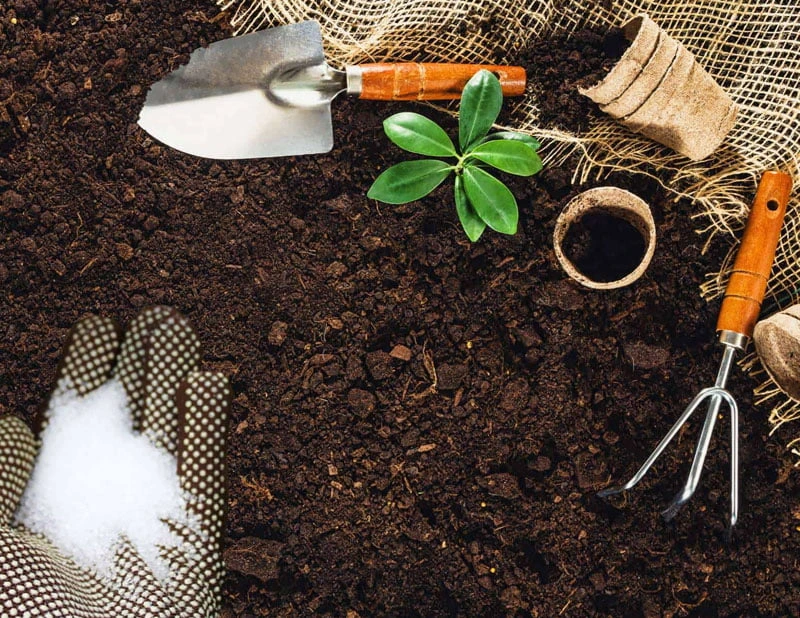Epsom salt has been used for centuries as a natural remedy for a variety of ailments, from sore muscles to constipation. But there are also benefits to using Epsom salt in your garden.
One of the main benefits of Epsom salt in the garden is its ability to improve soil quality. Magnesium, one of the key components of Epsom salt, is an essential nutrient for plants and is often lacking in soil. By adding Epsom salt to the soil, gardeners can improve soil structure, increase nutrient absorption, and promote overall plant health.
Epsom salt can also help plants grow stronger and produce more abundant blooms and fruit. Magnesium plays a key role in photosynthesis, the process by which plants convert sunlight into energy. So, if you’re having some troubles with your garden or you’re looking to get a good start this growing season, check this article out!
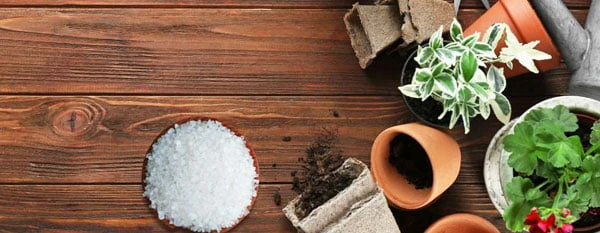
The Science Behind Epsom Salt
Magnesium and Chlorophyll Production
Epsom salt is a popular garden supplement that contains magnesium and sulfur. Magnesium is an essential nutrient for plants, and it plays a crucial role in photosynthesis. Chlorophyll, the molecule responsible for capturing light energy during photosynthesis, contains magnesium at its core. Without enough magnesium, plants cannot produce enough chlorophyll, which can lead to stunted growth and yellowing leaves.
Sulfur and Nutrient Absorption
Sulfur is another essential nutrient that plants need to grow. It is a component of many important molecules, including amino acids and proteins. Sulfur also helps plants absorb other nutrients, such as nitrogen and phosphorus, from the soil. Without enough sulfur, plants may struggle to take in these vital nutrients, which can lead to poor growth and development.
Putting Epsom salt in your garden can help provide plants with both magnesium and sulfur. When added to the soil, it dissolves and releases these nutrients, making them available to plant roots. This can help boost plant growth and improve overall health.
How Using Epsom Salt in Your Garden Improves Soil Health
Soil Test and pH Level
Before using Epsom salt in your garden, it is essential to test the soil’s pH level. The ideal pH range for most plants is between 6.0 and 7.0. Epsom salt is pH neutral (7.0) so applying it should not affect your soil pH. Some people think that the sulfur component tends to make soil more acid (pH goes down/smaller number) but field tests indicate that the affect is minimal.
Soil test kits can be fairly affordable. Sometimes your County Extension office or other local agricultural resource boards make these test kits available at or near cost. Another place to check is your state’s land grant university. In Colorado for example, we have Colorado State University that has many agricultural resources.
Nutrient Deficiencies
Epsom salt is an excellent source of magnesium and sulfur, two essential nutrients that plants need to grow. Magnesium is vital for chlorophyll production, which is necessary for photosynthesis. Sulfur is essential for the formation of amino acids, which are the building blocks of proteins.
Take Care to not Over-apply
Epsom salt can help correct these nutrient deficiencies in the soil. Be aware though, that overuse of Epsom salt can be detrimental to plants that do not need extra magnesium. Magnesium and sulfur can concentrate in soils that already have enough or too much of these nutrients.
What are the Signs of Magnesium Deficiency?
Some signs that your plants may be lacking magnesium include:
- Yellowing leaves – or brown or reddish spots in extreme situations. In grass lawns, you will see patches of grass that is yellowing.
- Stunted growth of plants
- Plant have very few blossoms
- Fruits that are produced look small or malnourished
Note that some signs like yellowing leaves can be caused by the lack of other nutrients or by disease.
What are the Signs of Sulfur Deficiency?
Lack of sulfur is harder to detect – and shares similar signs to the lack of magnesium: yellowing leaves and stunted plant or fruit growth.
Perform Your Own Nutrient Supplementation Experiment
Perhaps you haven’t had time to do a soil test, or the test you want seems a little spendy. If you suspect a magnesium deficiency, and you have several plants of the same kind, you could try your own experiment. Be sure to pick plants that are known to be sensitive to magnesium levels, such as Tomatoes, Peppers or Roses (more about those plants below).
Say that you have three tomato plants that aren’t doing as well as you’d like. Try adding a small amount of Epsom salt (1 tablespoon per 1 gallon of water), mix it up well, then water ONE of your plants with this water. Water your other plants with plain water. After the first application, water all three plants with plain water for at least two or three weeks. Did the test plant improve, or are all three plants still about the same?
You can even repeat the test on the same plant again. One plant’s worth of Magnesium and Sulfur will not hurt your soil and will eventually dissipate. However, if the test tomato plant improves, then you know that your soil could use a little supplementation.
Epsom Salt for Plant Growth
Seed Germination and Transplanting
Epsom salt has been shown to have positive effects on seed germination and transplanting. When used in soil, it can help improve the soil structure, which in turn promotes better root growth. This can lead to healthier plants that are better able to absorb nutrients from the soil.
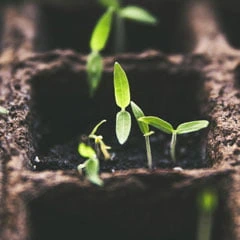
For seed germination, adding Epsom salt to the soil can help improve the overall health of the seedlings. The magnesium in Epsom salt can help the plants develop stronger cell walls, which can lead to stronger, healthier plants.
If you are using a packaged planting mix, check the package label first to see if the mix has already been supplemented with magnesium and sulfur. You may not need additional supplementation in this case. If you do supplement with Epsom salt, mix 1 tablespoon of dry salt with about a gallon of planting mix before starting your seeds or transplanting seedlings into bigger containers.
When transplanting, adding Epsom salt in your garden soil can help reduce transplant shock. This is because the magnesium in Epsom salt can help the plants absorb nutrients more efficiently, which can help them recover from the stress of being transplanted.
Foliar Spray and Foliage Health
Epsom salt can also be used as a foliar spray to promote foliage health. Foliar spray just means that you spray a solution of Epsom salt and water directly on the leaves and stems of a plant. This works best with magnesium loving plants that are fairly well established. Avoid this method on new plants with tender leaves or on plants that you don’t know if they benefit from extra magnesium.
If you are unsure if your particular plant is ready for the Foliar Spray method, you can spray onto a small portion of the plant, and just add the rest of the water around the roots. Observe your plant over the next two weeks to see if it is responding to the supplement.
To use Epsom salt as a foliar spray, mix 1 tablespoon of Epsom salt with 1 gallon of water. Spray the mixture onto the foliage of the plants, making sure to cover the entire surface area of the leaves. Repeat this process every two to three weeks for best results on plants that are responding to the spray.
Epsom Salt in Compost
Some people who know that they have a magnesium deficiency in all of their garden soil sometimes wonder if they can go with a general approach of adding Epsom salt directly to their compost. To learn more about that idea, please see our article Epsom Salt In Compost: Enhancing Quality and Nutrient Content.
Epsom Salt for Specific Plants
Roses
Epsom salt can be a great addition to the soil for roses. It can help to promote healthy growth and vibrant blooms. When planting new rose bushes, mix a tablespoon of Epsom salt into the soil at the bottom of the hole. If your roses are already established, you can sprinkle one tablespoon of Epsom salt around the base of the plant, or use the Foliar spray method mentioned above.
Tomatoes
Epsom salt can also benefit tomatoes and sometimes some of your other vegetables. For much more detail on this subject, please see Epsom Salt For Tomatoes: Maximum Yields With This Natural Supplement.
Pepper Plants
Pepper plants and similar plants like Chilies can also benefit from the use of Epsom salt. For much more detail on this subject, please see Epsom Salt for Pepper Plants: How To Use It For Premium Peppers.
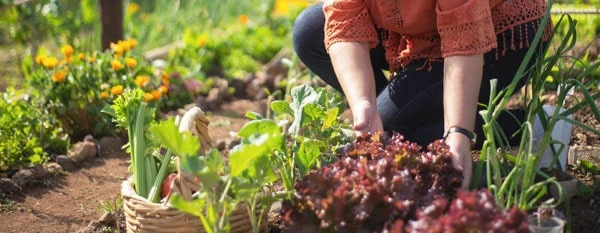
Grass Lawns
If you’ve already determined that the soil in your yard needs magnesium for your flowers and vegetables, it is likely that your lawn could also use some supplementation. When applying Epsom salt to a large area like a lawn, the most effective way to apply it is a hand-pumped sprayer. Sprayers like this are available at ‘big box’ home improvement stores and I often see them available very cheaply at thrift stores like ReStore. If you don’t want to spend the money on a sprayer, you can also just distribute dissolved Epsom salt using a watering can that has a bunch of small holes in the spout to create a shower dispersing the water.
The important part is completely dissolving the Epsom salt before starting!
If you put Epsom salt in cold water, it takes a long time to dissolve. Instead, start with hot water from the tap. Lawn pros suggest using about 2 pounds (four cups) of Epsom salt for 1000 square feet of lawn. Frankly, that is a lot of Epsom salt to get into solution! I find that I have better luck with putting a pound of salt (1 cup) in 3 gallons of hot water, then I disperse it around the lawn. Three gallons is typically what fits into a garden sprayer. Be sure not to put any undissolved Epson salt into your sprayer because it can quickly clog up the hose and spraying apparatus!
I wait & watch the lawn for results, and then I repeat the application a couple weeks later. Running the irrigation for a little while after applying Epsom salt can also help with even dispersion of the nutrients.
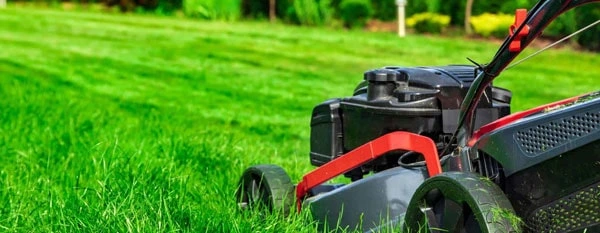
Common Myths About Epsom Salt
There are several myths surrounding the use of Epsom salt in your gardening. Here are a few of the most common ones:
Myth #1: Epsom salt is a fertilizer
Epsom salt is often mistaken for a fertilizer, but it is not. It is a source of magnesium and sulfur, which are essential nutrients for plants. However, it does not provide any other nutrients that plants need to grow. Therefore, it should not be used as a replacement for fertilizer.
Also note that some fertilizer blends supply magnesium and/or sulfur. Check the label carefully of the fertilizer that you are using to make sure that you are not over-supplementing.
Myth #2: Epsom salt can cure all plant problems
While adding Epsom salt in your garden can help with specific plant problems, it is not a cure-all. It can help with issues such as yellowing leaves, but it will not fix all plant problems. It is important to properly diagnose the issue before using Epsom salt as a solution.
Myth #3: Epsom salt can be used on all plants
Epsom salt is not suitable for all plants. Some plants, such as succulents and cacti, are sensitive to magnesium and can be harmed by Epsom salt. Conifers do not want extra magnesium. In vegetable gardens, bean plants also are not magnesium lovers, so take care when supplementing tomatoes and peppers. It is important to research which plants can benefit from Epsom salt before using it.
Myth #4: Epsom salt can be used in any amount
Using too much Epsom salt can be harmful to plants. More is not better. It is important to follow the recommended dosage for each plant and not exceed it. Using too much Epsom salt can cause a buildup of magnesium and sulfur in the soil, which can harm plants.
Final Thoughts
Putting Epsom salt in your garden can be an affordable tool for gardeners looking to improve the health and yield of their plants. Its benefits are numerous and varied, from promoting seed germination and root growth to deterring and disease. If you are looking for information on deterring pests in your garden, see Salt for Pest Control.
By incorporating Epsom salt into their gardening routine, gardeners can enjoy healthier and more productive plants without resorting to expensive or harmful chemicals.
Table of Contents
Seedling photo by Markus Spiske. Garden photo by Kampus Production.

